Methods for Cities to Produce Energy
By Jasmine Jin and Jacob Miske
Contents
Abstract
Energy production worldwide currently consists of roughly 10% carbon neutral sources.1 In order to lower carbon dioxide emissions, we need we will need a greater portion of power produced from more low-carbon sources and improve the yield efficiency of these energy sources. We propose that developing cities should meet at least 50% carbon neutrality and cities in more developed positions to meet 100% carbon neutral power production by 2050 This goal is based on modelings of a future with less than 50% of today’s carbon dioxide emission level in 2050 by the International Energy Agency (the “New Policies and 450 ppm scenario).2
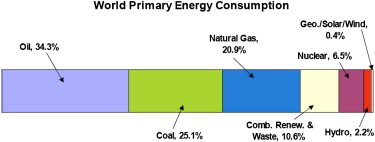
Figure 1.
Background
Challenges of Climate Change
Among the problems are concerns about the emissions that result from burning fossil fuels. Fossil fuels constitute a significant repository of carbon, in the form of methane (natural gas), octane (petroleum), and coal, buried deep underground. Burning them results in the conversion of carbon to carbon dioxide, which is then released into the atmosphere.1
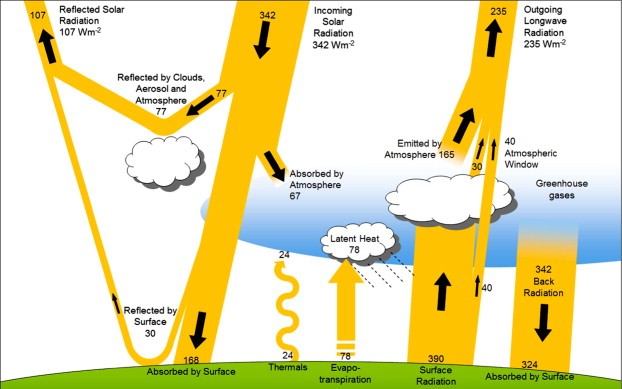
Figure 2.1
The estimated CO2 emission from the world’s electrical power industry is nearly 10 billion tons yearly.3 Emission at such large level can increase the concentration of CO2 by about 3.4 ppm. Under current increases in CO2, we are witnessing an increase in global average temperature by 0.7 degrees Celsius between 1964 and 2008. This is roughly .01 degrees Celsius per ppm CO2.4
For more details and descriptions on climate change, see the group’s article on air quality.
The Solutions
Each city’s individual energy solution to mitigate climate change and promote affordable, equity energy will have trade-offs and opportunity costs. These issues are hard to solve because they negatively affect a large number of individuals but no individual city is willing to act altruistically. For instance, the tragedy of the commons is involved when growing nations attempt to fuel their growth with fossil fuels. Debates between nations and their cities can be resolved by incentivizing large, developed nations to invest in clean energy for those growing cities according to the UN climate committee. Incentivizing the technology for developing cities that would like to develop renewables and nuclear would support the goals for both large and small cities to dispel climate change worries and establish greater renewables trade between states. Economist Kip Viscusi’s book Regulation and Anti-Trust shows this policy idea is explained by Stiglerian action. Stiglerian theory explains why many of corporations will not cooperate even when cooperating would benefit all parties. Regulations that support one energy over others will cause cities with strong resources in that energy source to benefit. Subsidies can help by selling tech or resources at discount to those competing cities. When nations work one-on-one, climate change will be mitigated in any outcome.
Climate change is currently challenging nations around the world that burn fossil fuels for energy purposes by threatening environmental stability. The main contributor to climate change is greenhouse gases, such as carbon dioxide, methane, and water vapor, that are products of combustion. The Intergovernmental Panel on Climate Change (IPCC) issued a global climate assessment in 2007. The assessment compared the relative influence exerted by key heat-trapping gases, small particles known as aerosols, and deforestation by humans on biomes and our climate between 1750 and 2005.5 The land use change is how humans have increased their use of land for agriculture and residential since the industrial revolution. The IPCC calculated the “radiative forcing” (RF) of each climate driver by measuring concentrations of various greenhouse gasses in the atmosphere—in other words, the net increase (or decrease) in the amount of energy reaching Earth’s surface attributable to that climate driver. Positive RF values represent average surface warming and negative values represent average surface cooling. CO2 has the highest positive RF of all the human-influenced climate drivers. Carbon dioxide and water vapor are produced largely as part of the power production process of combusting the complex carbons in fossil fuels. The biggest CO2 polluting power plants in the United States are coal-fired power plants.6 Low-carbon power presently comes mostly from nuclear and hydroelectric power plants which do not emit CO2 while producing power. Other low-carbon emission sources like hydropower, which requires large dams causes large land displacement, submerging large areas of soil behind a dam to create a reservoir.
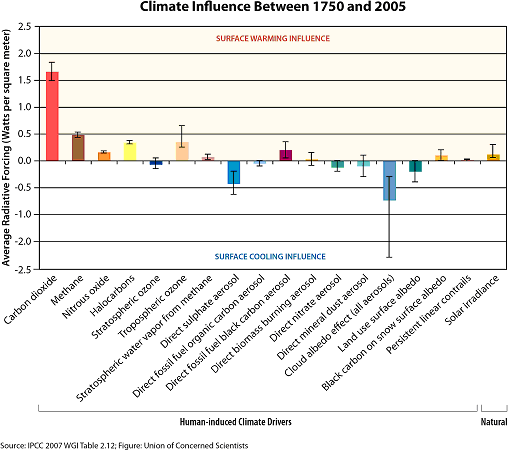
Figure 3.
Policy Solutions
This webpage examines the needs of constituency or general populace and their relationship with the business of power production. Future power production should serve the interests of the constituency and not just profits. Electricity is becoming a basic right in many countries. There are currently two methods of energy production that will be focused on and four conditions that dictate how this policy recommendation will play out in a city by city basis. Situational status refers to the various factors that affect how a city can support a reliable grid with low carbon emissions. The two power sources we examine are nuclear power, and renewable power. Circumstantial examples involve geography, socio economic, political environment, and power dependence.7 See table below.
| Factors involved in a city’s energy future | ||
| Energy Choice | ⇦ | Circumstance |
| Nuclear | Environmental and Climate | |
| Solar | Politics | |
| Hydro | Social-economics | |
| Wind | Power dependence | |
| Table 1. | ||
This webpage will examine the various gradients and provide a model on how to use them.
Introduction and key concepts
Energy production methods are outdated and can create considerable problems. The market for producing power is built upon a grid of lines and cables. The electrical grid connects power suppliers and power consumers. The power suppliers are power plants and the consumers are residential, business, industry, etc. The power a city uses on the day to day basis at any given time is called base load power according to the US Department of Energy.8 Carbon based (non-renewable), nuclear, and renewable power will be treated as three separate sources.9 Carbon will be descriptive largely of oil, coal, and gas. Energy production methods using coal and oil are over a century old and considered obsolete by the Union of Concerned Scientists, therefore fossil fuels should be stepping down for new sources.
Differences in political sphere, geography, and socio-economics
In the 2015 world energy council summit, they proposed two scenarios for 2050 entirely dependent on the degree of action that government would take in the development of cleaner and more efficient power production methods. The two scenarios are called Jazz and Symphony. As an energy scenario, Jazz has a focus on energy equity with priority given to achieving individual access and affordability of energy through economic growth. As an energy scenario, Symphony has a focus on achieving environmental sustainability through internationally coordinated policies and practices. Energy access and equity is elaborated in a piece by Weiss “Universal Energy Access.” Is this piece, the author goes over how differences in the current energy equity situation can be averted.
Power dependence is one city’s reliance on another for energy. Dependence is a negative attribute because it can lead to energy insecurity. Many nations seek to remove their reliance on others for peak power surges and imports. This supports many of the other goals we have mentioned. Renewables rely on power production close to the power user. This leads to energy independence for entities seeking to develop cleaner power. Some nations have affinity for reactors because of the low amount of radioactive waste and some nations can produce natural gas from the deposits in their own country very easily.9 Electricity independence is not guaranteed. Direct solar will not fare well in the American Northwest as well as it does in Northwest Africa as opposed to diffuse solar. Geography can affect the viability of certain renewables. HomeSolar provides estimates for various regions around the US.10
Variables in Solutions
Solutions for mitigating climate change and providing affordable energy production levels must change depending on how we mitigate climate change by using different energy production methods and efficiency tactics elaborated on in Building Efficiency by Glinski. The different circumstances affect the current models of power production in urban areas throughout the globe (see Table 1 above) in negative, polluting ways that bother public health. Less-centralized governments should move towards more individualized renewable energy sources like solar and geothermal. Personalized sources supply power for individual households and are usually installed by a green tech company or by the homeowner.
Technological Solutions
To address the climate change challenge, there are many diverse solutions that countries and cities can choose from to suit their needs and circumstances. The first solution is improving nuclear technologies. Recycling the material can greatly reduce the quantity of radioactive waste.6 Nuclear fuel recycling involves re-enriching fuel once it stops emitting energized particles. A second solution is to improve solar efficiency. Homeowners with hopes to be energy independent are installing photovoltaics on their roofs. (See The Importance of Energy Storage, an article by Ryan Shubert to learn more about the efficiency developments in battery tech and solenoids.) Now we will go over the above mentioned technological solutions in more detail.10
Solar, wind, and hydroelectric power are becoming easier to access for the individual over time as manufacturing processes develop. Companies are establishing models to install solar on roofs, and start-ups help individuals to install hydroelectric turbines in nearby streams.11
Nuclear Energy
Centralized governments closely linked to providing power to their citizens should invest in nuclear power. Costa Rica Environmental Ministry has supplemented their entire electrical grid with solar, hydroelectric, and wind power. Chinese state-run nuclear uses large reactor designs in the western provinces to provide the electricity required for the eastern coast cities. According to an NREL study examining renewable energy integration in the US, 80% of US electricity could be coming from renewables by 2050.12 This is contingent upon what investments and tech will be developed.
Downside
Nuclear energy, though emitting less greenhouse gases than burning coal or oil and the waste can be contained as a solid as opposed to gasses, still has environmental and health effects. Accidents can happen in any given nuclear reactor that can cause great harm. Radiation exposure accidents can cause radiation sickness and cancer. These risks are found in different levels for each energy sector Mining uranium ore can contaminate and destroy the environment around the mine.9 The containment and disposal of waste involves an industry for containment as well as transportation. Diversion of fresh or burnt fuel to weapons production presents a risk of nuclear proliferation. This means that in the current processes of nuclear power, the waste could be used as a weapon. Finally, the NRC has shown that the structure of the reactor itself becomes radioactive just like its waste and will require decades of storage before it can be economically dismantled and in turn disposed of as waste.10 Disposal of burnt nuclear fuel is controversial, with many proposed long-term storage schemes under intense review and criticism, such as the Yucca mountain waste disposal plan.3
Nuclear Upsides
The radioactivity dangers associated with nuclear are brought up in energy debates. However, there are risks and dangers in every power industry. The largest U.S. power plant to win a green rating for nearly-zero CO2 emissions is the Palo Verde nuclear plant near Phoenix, Arizona. It produces about 26 million megawatt-hours (MWh) of electricity per year, enough to light 5 million homes. Nuclear power plants produce electricity on the same scale as coal fired plants and emit zero CO2 during the actual production of power according to the NRC.1 A number of energy companies have a stake in producing renewable, nuclear, and carbon based power such as Westinghouse, Shell, and EDF.10 Companies with a stake in both fossil fuels and nuclear will not be significantly harmed moving over from majority fossil fuel to majority nuclear fuel. Nuclear power can be used as a stepping stone to stray away from carbon fuels while renewables are developed further. Later on, these reactors will be retired when they are not cost effective as compared to renewables. Scientists disagree with each other over how to dispose of nuclear waste. In the US, the Yucca mountain site was created to hold 70 thousand metric tons of waste. This could hold several thousands of years’ worth of nuclear waste,1 taking into account increasing waste for the nuclear power increase and estimates for reducing waste based on new reactor technologies. At the same time, regulatory laws require that these sites must be designed to hold waste for over a quarter of a million years.9 We think that this is enough margin to establish nuclear plants to replace fossil fuels until renewables are reliable enough to take the majority of the energy.
Nuclear risks have resulted in less deaths and injuries than any other form of power according to the Union of Concerned Scientists. Energy diversification is the use of multiple sources and is encouraged to increase energy stability.1 As for the economic side, nuclear costs change due to market scale production and because diversifying power sources will increase market competition and drive down prices to appeal to consumers. Some consumers prefer solar and wind for various reasons. City utilities can cooperate with large power companies, like Westinghouse, that produce nuclear power.9 Nuclear allows us to get away from fossil fuels before dangerous temperature rises by replacing energy from fossil fuels.
Solar Energy
Facing a likely 79% increase in global demand, mostly in cities, for electricity by the year 2050, renewable energy from wind and solar will need to play a much larger role in electricity production in 2050. As already noted, relying solely on nuclear energy in the future is unlikely and an imperfect solution due to the risks associated with nuclear reactors. Nuclear energy will take on the lion’s share of base load power in nations with established nuclear infrastructure and can begin to take on base load in nations currently developing nuclear infrastructure. Currently, solar energy accounts for only about 1% of the electricity production in the world, and in scenarios modeled by International Energy Agency (IEA) for energy-related CO2 emissions to fall to 50% of the current level (the minimum projection of 560 ppm) by 2050, solar energy needs to supply at least 27% of the electricity production with hydroelectric power, wind power, and nuclear energy making up the rest.2 Solar energy’s intermittency, cost, and scaling still pose the most significant challenges in implementing solar energy in electricity production for cities. In this section, we will highlight two ways of harvesting solar energy, solar photovoltaics (PV) and Concentrated Solar Power (CSP) and how they can approach these challenges in the future.
Solar PV
Currently, the most common form of harvesting solar energy is through solar photovoltaic cells. The majority of commercially available PV cells use crystalline silicon, and they consist of a protective transparent layer on top of two layers of semiconducting materials with opposite mobile charges, creating an electric field at the junction.13 When light strikes the material, electrons gain potential energy as they are pushed against the electric field.14
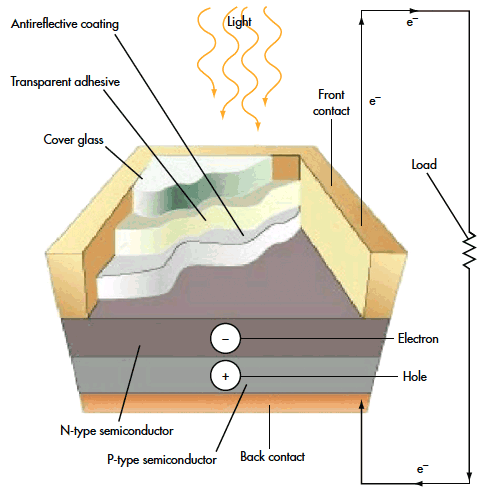
Figure 4. Illustration of a silicon wafer PV.13
The commercially available solar panels use crystalline silicon (c-Si), which is used to manufacture solar panels that are non-toxic, stable, and reliable. A major limitation of c-Si is its relatively poor ability to absorb light, so it uses thick and brittle wafers, which cost more and make power-to-weight ratio low.13 Despite such limitation, PV cells using c-Si are scalable and can still reach electricity production at terawatt-scale by 2050, a step toward satisfying the projected 26 terawatt electricity demand in 2050.2 (We do not expect a single source of energy to satisfy the whole demand because other forms of renewable energies and nuclear will also contribute.)
A potentially less costly alternative in the future is thin-film solar panel, which uses alternative materials to replace c-Si. Thin film solar panels have similar structures to c-Si cells, also consisting of protective and semiconducting layers, and operate based on the same principles.13
Below is an illustration of a thin-film PV.
![Figure 4. Illustration of a silicon wafer PV.[16]](http://mission2020.mit.edu/wp-content/uploads/2016/11/miski5.png)
Figure 5. Illustration of a thin-film PV.13
Current commercially available thin-film PV technology uses CdTe, copper indium gallium diselenide, and hydrogenated amorphous silicon, which can absorb light 10-100 times more efficiently than silicon.2 Thin film PV can reduce the cost by using significantly less materials and tolerating higher levels of defects in materials. Lighter than c-Si PV cells, thin film solar panels are also great options for rooftop solar panels.13 Currently, they have lower sunlight-to-voltage conversion efficiency, so the overall cost of thin-film cells is still comparable to that of c-Si based cells. Thin-film cells also depend on some rare and toxic elements, and such dependency can limit the level of manufacturing and range of applications. However, because of their attractive features, such as light-weight and low production cost, thin-film technology will still remain competitive in the market, and companies have incentives to innovate to further improve the efficiency and lower the cost of thin-film solar cells.15
A major worry about the feasibility of solar energy concerns intermittency of sun exposure which can not only vary from season to season but also during the day when cloud coverage changes. This concern can be addressed by storing the surplus of energy generated by the solar PV during sunny hours with low electricity demand can be stored in a battery for future use (see Ryan Shubert’s article Energy Efficiency for more information on batteries). Even without long-term storage over days or seasons, the intermittency of solar energy can be managed by connecting to the grid because the existing grid system already has the flexibility to respond to changes.16
To make supplying a considerable portion of electricity demand in cities with solar a more viable plan, future innovations and advancements in technology need to aim to improve efficiency of solar panels on the market, reduce manufacturing complexity and costs, lower power-to-weight ratio for c-Si cells, and engineer thin-film PVs less dependent on toxic or rare elements.2
City governments should not only subsidize research and innovation in this direction, but also build network infrastructures including cables, transformers, protections, insulators, that will allow interconnected electric power systems to send electricity from generators to cities to better integrate solar PV.2
Concentrating Solar Power (CSP)
Besides solar PV, Concentrated Solar Power (CSP) also has a lot of advantages and potential for future improvements to supplement solar PV.
A concentrating solar power plant uses a large parabolic mirror which tracks the movement of the sun and concentrates sunlight to heat a fluid and generate steam to power a turbine which generates electricity.17
![Figure 6.[20]](http://mission2020.mit.edu/wp-content/uploads/2016/11/miski6.png)
Figure 6.17
CSP is a good way of harvesting solar energy because, instead of converting energy from sunlight directly to electricity, it converts energy from sunlight first to heat and then to electricity. Having heat as an intermediate form allows it to incorporate and hybridize with other thermal generation options, and thermal energy storage is very efficient using molten salt.2
CSP systems can use the stored heat to generate electricity for hours or even days when sunshine is not available but it lacks long-term (over months or seasons) storage capacity. Unlike solar PV, CSP is also sensitive to scale and needs to be large enough to reach optimal technological and economic efficiency. CSP needs large areas of flat land (about 5 acres per MW capacity) and a water supply to generate steam and clean the mirror. It could have major applications in cities near large areas of flat land and with access to water, such as those in the southwest region of the United States and the north region of Africa.18
Case Studies
This section looks at specific examples of applications of different solar technologies and models for possible solutions.
Solar PV in Bangladesh
Bangladesh is a developing nation in south Asia. The government of Bangladesh launched a Solar Home System (SHS) Project in 2003, aiming to power entire cities with solar energy by 2021. It had already installed 10% of the total 3.5 million households with SHS by 2014.19 As of June 2016, more than 1.5 million households and business have access to electricity produced from clean energy, and Bangladesh is on track to reach their goals of 2 million by 2018 and 3.5 million by 2021.20 The number of households benefiting from rooftop solar panels proves that solar PV can be scaled up to a high enough level to match demand as would be encountered in cities.
The Bangladeshi government provided low interest loans to private companies to install SHS, encouraged both domestic and foreign investments in plants, and built infrastructure such as solar grids and solar power plant.21 These actions serve as great examples for policy and decision makers of the future cities.
![Figure 7.[18]](http://mission2020.mit.edu/wp-content/uploads/2016/11/miski7.png)
Figure 7.19
CSP in Morocco
Morocco is in the north region of Africa and has high level of sunlight exposure and large areas of flat land. This February (2016), Morocco launched a project to build the world’s largest CSP plant at a site 10km away from the city of Ouarzazate, home to around 583 thousand people. The CSP plant, when completed, is expected to power over one million homes, reduce carbon emission by 760 000 tons per year, reduce the country’s dependence on imported fossil fuels, and increase the share of renewable energy in total electricity generation from 13% to 42%.11
Case Study in India
India is an example of a large nation transitioning to modern cityscapes. Almost 70%of India’s electricity today comes from coal-fired plants. The specific stats are described in the pie charts below. Over the next 25 years, the most aggressive assumptions in terms of renewables could increase renewable usage 18 or 20 percent. One form of renewable energy in particular, hydroelectric, takes longer than implementing solar and wind due to displacement of people and submerging land. Under the best scenario for India— with the most aggressive programs for nuclear, hydro, solar, and wind– fossil fuels will still be at 50%.12 While low or zero carbon sources would make up a greater portion of India’s energy supply, overall carbon emissions would nearly double because new power consuming individuals are projected to be born leading to from around 2.1 billion tons of coal in 2014 to more than four billion tons by 2040, according to the International Energy Agency.6 When cities grow without advancements in energy production or help from third party investment companies, nations like India will have a hard time developing their energy goals of meeting 50% carbon neutral sources. Other places around the globe rely on other forms of energy. Other examples exist in New York and London. The Indian Point nuclear power plant near New York City provides 25% of New York’s power. New York invests in the plant because it has a great record with base load power production. Strong reliable base load power production can provide stability to any city because it is the amount of power a city is always using.
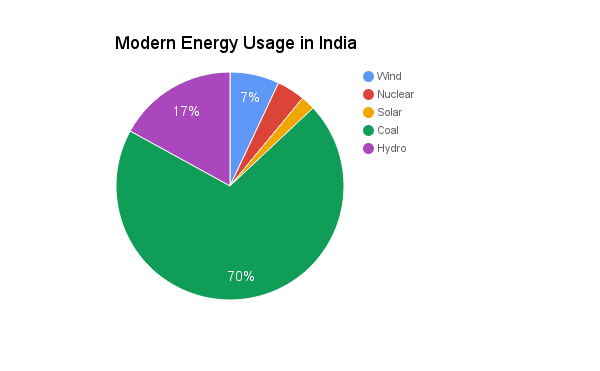
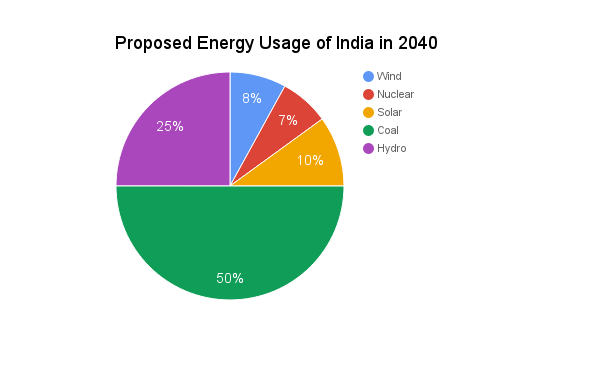
Figure 8. Statistics from Ramesh.12
Value of Solutions
Social economics determine what a nation is going to be able to afford and sponsor. Many growing cities in Africa do not have the manpower and financial base to build nuclear plants but can support strong solar, wind, and hydroelectric power.6 Nuclear power plants have large up-front costs compared to renewables or fossil fuels. Nuclear plants can cost between 2 to 4 billion dollars.9 A hydroelectric dam the size of Hoover Dam, which provides most of Las Vegas’s energy, costs three-quarters of a billion dollars. An acre of solar farms costs about half a million dollars.
The largest U.S. nuclear plant in Palo Verde, Arizona, produces a total of 3,937 megawatts.12 Whereas presently, the Hoover Dam can produce over 2,000 megawatts of capacity and a yearly average generation of 4.5 billion kilowatt hours to serve the annual electrical needs of nearly 8 million people in Arizona, southern California, and southern Nevada. A large photovoltaic plant that generates 1000 megawatts per year requires, on average, 2.8 acres for the solar panels.7 A solar power plant that provides all of the electricity for 1,000 homes would require 32 acres of land. Consider that the average American household in 2015 consisted of 2.54 people.
| Cost (USD) | Fuel Price | Land-use | |
| Nuclear | 2-4 billion | $35.50 | 2 Sq Miles |
| Hydro (Hoover Dam) | .75 billion | ~$50.00 | 14 Sq Miles (includes reservoir) |
| Solar | 1 billion | $144.30 | 62 Sq Miles |
| Table 2. | |||
If the nearly 8 million people or 3.15 million homes that hoover dam produces power for were all supplied by solar power. Cost is also a factor on whether individuals can afford power. Due to the amount of energy per unit of fuel, nuclear reactors can produce energy at $35.50 per megawatt-hour as compared to the total system cost for a natural gas combined cycle plant at $65.60 per MWh; onshore wind is $86.60 per MWh; offshore wind, $221.50; and solar, $144.30.7,22 Unlike renewable sources, however, nuclear energy facilities produce electricity around the clock, making it an economical and sustainable choice for reducing emissions while renewables can be introduced at a steady pace as they improve in efficiency.
Implementation Logistics
As explained in the background, there are two discuss options of power production source and four areas of consideration that dictate how this policy recommendation will play out in a city by city standard. The two power sources include nuclear power and renewable power. The four circumstances examined are the geography, socio economic, political environment, and power dependence. When choosing between energy options today, cities should strive to meet higher and higher levels of renewables and moving from fossil fuels to nuclear. Sometimes, circumstance affects the reliability of the solution a city must create and clever solutions in our case studies were expanded upon. Look on Table 1 in section Background for reference.
Energy Future
Cleaner fossil fuels involves the technology being developed that restricts the burning of coal and oil and promotes natural gas brayton power cycles that remove toxic particulates as much as possible while maintaining a high power density. Nuclear power investment involves using reactors to supplement power to large metropolitan areas as opposed to combustion plants. Breeder reactors can be built close to civilized areas and the fuel can continuously be recycled. Modular reactors can be moved around as freight pieces, allowing them to be used akin to generators. Power generated from renewables is generated in the geographic area which they support. Complete renewable reliability and centralized nuclear is the best situation in the long term to meet energy goals. Centralized nuclear power plants are those that are constructed between urban areas to provide power evenly between cities. However, the timeline to 2050 will be one of gradual efficiency standard setting and not all nations will be able to reasonably afford such drastic measures. This imbalance in affordability should be resolved by allowing international interest firms to invest in clean energy for developing cities in India and China.
Government Actions and Funding Suggestions
- Subsidizing research and encourage innovation:
Although the existing technologies are already promising, there are many areas that can be improved upon to decrease cost and increase efficiency. There are also emerging alternative technologies, such as solar ink and semi-transparent solar panels that can possibly open up new windows and break through some current limits.14
- Build infrastructures needed and allocate resources
Most renewable energies can be produced locally, but Grid-connected PV and CSP still require governments to build infrastructure to integrate them into the electricity generation. Nuclear power plants and reactors also require significant investments and support from governments.
Both solar and wind critics argue they are not particularly pleasing from an aesthetic point of view in certain places of the world when built close to cities where necessary according to polls organized by CNN. However, governments can allocate city resources to deploy these renewable technologies unobtrusively: fixed solar collectors cbe laid down as extensive roadway, parking lot, and roof-top area; semi- or entirely transparent photovoltaic cells can serve a dual purpose to tint windows and produce energy.
- Investment in and cooperation with private companies that develop and implement renewable energy
- Cap and Trade policy
According to a report done by MIT Energy Initiative, since most renewable energies are still more expensive than burning fossil fuels, governments can put prices on carbon dioxide emission to level the playing field for renewable energy and fossil fuels and provide more incentive for developing renewable energy at lower costs.2
- World Bank’s Clean Technology Fund:
The Clean Technology Fund is 5.6 billion-dollar fund under the Climate Change Investments by the World Bank. It can help provide resources to developing nations to commit to low-carbon emission technologies, and countries can tailor the investment plans to their own development strategies, goals, and special situations.23 Both Morocco and Bangladesh took loans from the World Bank to finance their initiatives on renewable energy, and they can expect great returns to their investments as illustrated in the case studies. The Green Climate Fund from the Paris Agreement makes these ideas a reality. Adding renewable energy allows more people to access electricity and diversifies the domestic economy and energy production.11
Conclusion
We propose that city governments take actions to incentivise the shift from heavily relying carbon-based energy production to toward maximizing percentage of power production from low-carbon emission sources. The goal is to replace the use of fossil fuels with nuclear energy and solar energy. The initial costs of implementing both nuclear and solar power are expected to be high, but loans are available to surmount that barrier, and the jobs created and new capital used will help offset these economic costs for cities. We acknowledge that while developed cities should rely 100% on renewable energy, developing cities in 2050 can and should strive to reach more than 50% renewables.
